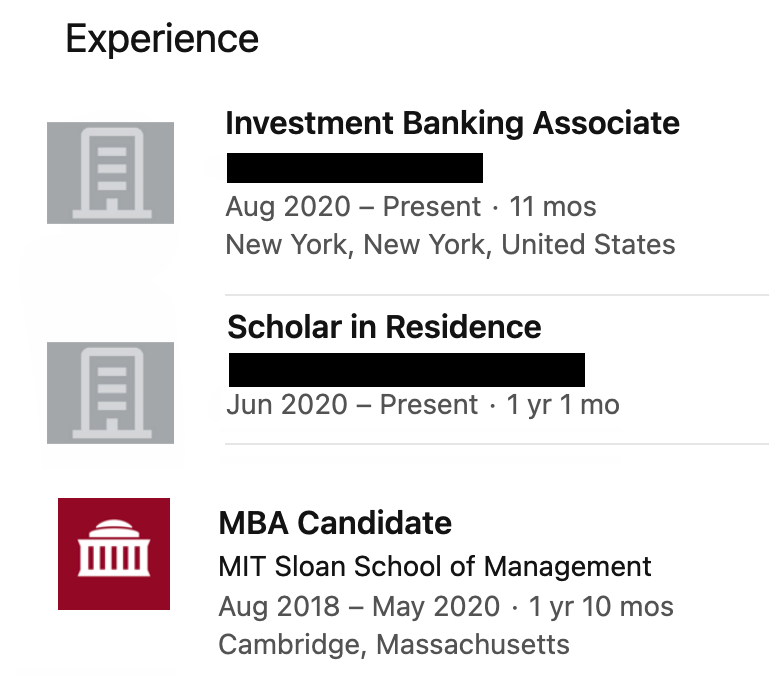Menlo Coaching Industry Reports Research Methodology
Menlo Coaching has analyzed 51,991 student profiles (and counting…) to give you information about the pre-MBA backgrounds and post-MBA job outcomes of students at top MBA programs.
This information is gathered strictly from public sources, including publicly posted lists of students, such as virtual graduation announcements, and social media profiles on sites like Facebook and LinkedIn.
Industry Reports from Menlo Coaching
Wherever possible, we create a data set including the following attributes for each student:
- Undergraduate institution, including major and graduation date
- All full-time and internship employment, including companies, start dates, end dates, locations and job titles
- MBA program attended, which we further classify as full-time, part-time, executive, or as a joint degree program, and the associated graduation date
Errors and omissions in this data are corrected by a mix of automated and manual processes. For example:
- When we saw 2020 graduates who worked for a short time after graduation at non-profit institutions such as museums, and then started traditional post-MBA employment at management consulting firms in January 2021, we concluded that the management consulting job offer start dates had been delayed because of the COVID pandemic, and treated those (not the short-term non-profit jobs) as the post-MBA employment for those students.
- If a student’s social media profile does not list dates for their MBA explicitly, but there is an employment gap of roughly two years, we deduce that the MBA happened during that gap.
This list is meant only to illustrate the types of corrections we make and is not an exhaustive list of the steps we take to produce accurate data.
Why are we creating this data?
Although MBA employment reports published by business schools are a great starting point, they do not answer all of the questions that applicants have about each MBA program’s career placement.
First, per-employer data are not consistently available across all MBA programs, which makes it tough to compare all of your target business schools. We applaud the MBA programs that do publish per-employer stats, but this is not yet a universal practice.
Second, even at MBA programs that do publish the number of students hired by each top employer, applicants still have important questions that remain unanswered. Questions like:
- I want to work in the tech industry in Boston because my family lives there. Which MBA program has the best placement in Boston’s tech industry?
- Before my MBA, I studied and worked in China. Which post-MBA jobs do other Chinese graduates get?
- I want to work at Google. Which MBA program sends the most graduates to Google?
- I’m excited about working in tech, but I’m not sure which job is right for me. What are the most common post-MBA jobs in the tech industry?
The MBA is the most important career decision that most young professionals will make, and applicants deserve answers to these types of questions.
What are the potential issues with data from public sources?
- Not all students maintain their social media profiles in a timely manner. If a student does not update their public profiles, we will not have updated information on that student.
- Not all students fill out their social media profiles accurately. For example, students may fill out only a partial job title; if someone works at Goldman Sachs, but in the Treasury Department rather than the Investment Banking Division, they may list their job title as “Associate” rather than “Associate – Treasury.”
- It is not always possible to determine whether a student is enrolled in a full-time, part-time or executive program. An EMBA student who is between jobs during the program may appear on paper to be a full-time MBA student.
- Graduates who take an interim position for longer than a few months can present a challenge to post-MBA industry classification. Consider the following case from an anonymized profile:
Without human intervention, the post-MBA industry from the above profile might be classified based on employer data associated with the 1 year position as a “Scholar in Residence.” And in a certain sense, this automated classification would be correct. That is the first position the graduate accepted after MIT Sloan.
Nonetheless, a human evaluating the profile would probably know that, in the context of an MBA degree, the investment banking job is the “real” post-MBA job. This specific case underscores a general truth regarding the public profile data of MBA students: some degree of ambiguity is unavoidable.
How does this data compare to the employment reports published by MBA programs?
Employment reports are based on survey results. These are generally accurate, but:
- A handful of students do not complete the surveys.
- Some students may answer surveys inaccurately. For example, MBA programs might pressure students who have not secured full-time jobs to claim that they are pursuing entrepreneurship and are therefore not searching for jobs.
- We have heard rumors of one lower-ranked regional MBA program that offers on-campus employment to recent graduates as a way to raise the percentage of students considered to be employed at graduation.
We would assume that specific factual claims about the numbers of students employed at named firms are correct if included in MBA employment reports. However, we prefer to use public data across all programs to create an apples-to-apples comparison between schools that do disclose per-employer stats and schools that do not disclose per-employer stats.
In general, employment reports are based on MBA CSEA standards, which dictate the breakdown structure for region, industry and function. We capture data at a lower level of granularity by recording the exact city (not just the region) the exact employer (not just the industry) and the exact job title (not just the function).
Our data is also updated on an ongoing basis rather than being based on surveys at specific points in time and may therefore capture students who accepted their first jobs with some delay after graduation.

